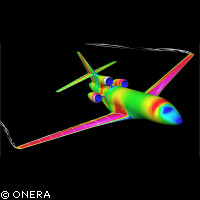Clean Sky JTI takes off
'Today is a great day,' said European Science Commissioner Janez Potocnik at the launch forum of the 'Clean Sky' Joint Technology Initiative (JTI) that aims to put Europe at the cutting edge of greener aircraft design. The goal of the €1.6 billion initiative is to improve the environmental performance and competitiveness of Europe's aeronautics industry by developing 'cleaner, more competitive technologies'. 'The challenges that stand before us today, such as boosting international competitiveness and tackling climate change, are common to all European countries, and research is a major part of the answer,' the Commissioner said. 'We stand a better chance to making a difference if we work together. This is the basic logic behind the Clean Sky JTI and I am delighted that it is now underway and ready to start its work,' he added. The JTI, a public-private partnership between industry, the research community and the European Commission, will invest in research and innovation with the goal of reducing the environmental impact of air transport by lowering noise and gaseous emissions and improving the fuel economy of aircraft. The concrete objectives are to reduce carbon dioxide (CO2) emissions by 40%, nitrous oxide (NOx) emissions by 40% and noise emissions by the order of 20 decibels. It is hoped that these advances will be made in time for the next generation of aircraft to enter into service from 2015. 'For me, one of the most remarkable things about the initiative is the diverse group of contributors that we have brought together aboard our forthcoming flight. All of these passengers are agreed on the direction they wish to take,' said Mr Potocnik. So far, 86 organisations from 16 countries have jumped on board, including all the major aeronautical players in Europe, as well as 20 small and medium sized enterprises (SMEs), 15 research centres and 17 universities. As one of Europe's largest research programmes, the Clean Sky initiative will have an estimated budget of €1.6 billion, provided equally between the European Commission and the aviation industry over the next seven years. During this time, the Commission also expects the initiative to have a 'leverage effect' on national research budgets, and to lead to the creation of a new Joint Undertaking establishing a Single European Sky. Ake Svensson, President of the Aerospace and Defence Industries Association of Europe (ASD), accepted that industry had a responsibility to clean up its act. It currently accounts for about 3% of CO2 emissions worldwide, whilst that figure is only set to grow as passenger numbers are increasing by 5% every year. 'We recognise that this carbon footprint is not at all acceptable. We want to work together to find solutions. But real usable technologies must come of this initiative - ones that industry can use,' he said. Within the JTI, groups called Integrated Technology Demonstrators (ITDs) will carry out preliminary studies and then validate them through full-scale demonstrators in six key areas. They will develop innovative technologies that can be applied to the next generation of aircraft. The SMART fixed wing aircraft ITD will develop active wing technologies that sense airflow and adapt their shape as necessary, while the Green Regional Aircraft ITD will focus on low-weight configurations and technologies, as well as the integration of technology developed in other ITDs. Developing innovative rotor blades and decreasing airframe drag are among the priorities for the Green Rotorcraft ITD. Meanwhile, the Sustainable and Green Engine ITD will work on technologies to lower noise levels, decrease NOx emissions and improve efficiency. The Systems for Green Operations ITD will focus on aircraft equipment and systems architectures, capabilities for 'green' trajectories and improved ground operations. Finally, the Eco-Design ITD will address the full life cycle of material and components, with an emphasis on optimising the use of raw materials, and decreasing the usage of natural resources and energy. A technology evaluator will be responsible for assessing the contribution of the six ITDs to the overall environmental objectives of the project. The Clean Sky JTI will be overseen by an executive board and an executive office. The board will comprise representatives of the Commission and founding members of the JTI. The executive office will be headed by a joint undertaking director and the ITD steering committees. The Clean Sky JTI is the second such initiative to be launched after the ENIAC JTI on nano-electronics. Other initiatives in the pipeline include JTIs on embedded systems technology, innovative medicines and hydrogen and fuel cells.



